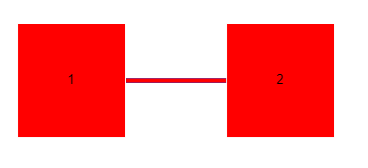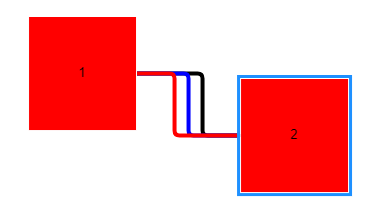Hi all,
I want the same port links don’t overlap like below:
But I don’t know what to set, and actually my code is get overlap links like below sample:

And it did not show all the links until I dragged it.

So what link attributes should I set to achieve the effect of my first map?
This is my sample code:
function init() {
if (window.goSamples) goSamples(); // init for these samples -- you don't need to call this
var $ = go.GraphObject.make; // for conciseness in defining templates
myDiagram =
$(go.Diagram, "myDiagramDiv");
// define the Node template
myDiagram.nodeTemplate =
$(go.Node, "Auto",
$(go.Shape, { fill: "red", stroke:"white" }),
$(go.TextBlock, { margin: 50 },
new go.Binding("text"))
);
// define the Link template
myDiagram.linkTemplate =
//this AvoidsNodes is invaild when I append nodes/links like that
$(go.Link, go.Link.AvoidsNodes,
{ corner: 5 },
$(go.Shape, {strokeWidth: 4},
new go.Binding("stroke", "color")
)); // the link shape
myDiagram.model = $(go.GraphLinksModel);
myDiagram.model.nodeDataArray = [
{ key: 1, group: 66, text: "1" },
{ key: 2, group: 66, text: "2" },
{ key: 66, isGroup: true, group: 88 },
{ key: 88, isGroup: true }];
myDiagram.model.linkDataArray = [
{ from: 1, to: 2, color: "black" },
{ from: 1, to: 2, color: "blue" },
{ from: 1, to: 2, color: "red" }
];
myDiagram.groupTemplate = $(go.Group, "Auto",
{
layout: go.GraphObject.make(go.TreeLayout,
{ arrangement: go.TreeLayout.ArrangementVertical, layerSpacing: 100 },
),
isSubGraphExpanded: true,
//avoidable for group is false
avoidable: false
},
go.GraphObject.make(go.Shape, "Rectangle",
{ fill: null, stroke: "gray", strokeWidth: 2 }),
go.GraphObject.make(go.Panel, "Vertical",
{ defaultAlignment: go.Spot.Left, margin: 30 },
go.GraphObject.make(go.Panel, "Horizontal",
{ defaultAlignment: go.Spot.Top },
// the SubGraphExpanderButton is a panel that functions as a button to expand or collapse the subGraph
go.GraphObject.make("SubGraphExpanderButton"),
go.GraphObject.make(go.TextBlock,
{ font: "Bold 18px Sans-Serif", margin: 4 }
),
// create a placeholder to represent the area where the contents of the group are
go.GraphObject.make(go.Placeholder,
{ padding: new go.Margin(10, 30) })
)
));
}
Thanks,
Peter
